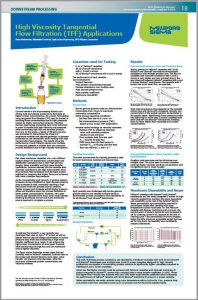 Current trends in the bioprocessing industry are driving mAb and plasma producers to formulate at higher protein concentrations. As a result, formulating using tangential flow filtration (TFF) may be limited in reaching these concentrations due to high pressures caused by highly viscous feed streams. Filtration devices used during processing have to be optimized in order to handle both high viscosity and pressures while maintaining high flux and excellent product recovery. In this study, a family of filtration devices was evaluated to characterize the impact of membrane material and channel geometry on process performance and cleanability when working with high concentration feed streams. The results show the performance of each filtration device over multiple re-uses and presents a solution that can overcome process limitations due to high viscosity formulations.
Current trends in the bioprocessing industry are driving mAb and plasma producers to formulate at higher protein concentrations. As a result, formulating using tangential flow filtration (TFF) may be limited in reaching these concentrations due to high pressures caused by highly viscous feed streams. Filtration devices used during processing have to be optimized in order to handle both high viscosity and pressures while maintaining high flux and excellent product recovery. In this study, a family of filtration devices was evaluated to characterize the impact of membrane material and channel geometry on process performance and cleanability when working with high concentration feed streams. The results show the performance of each filtration device over multiple re-uses and presents a solution that can overcome process limitations due to high viscosity formulations.
Sunday September 14, 2025
